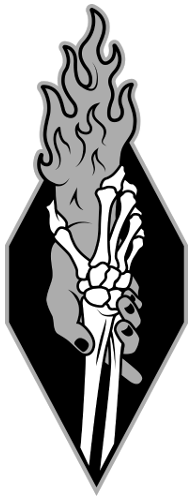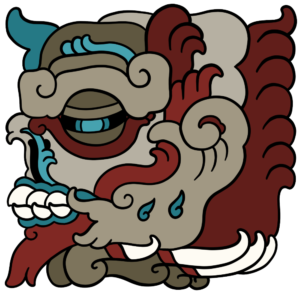We enjoy the aesthetics of deviltry and witchery, the horns and bats and all manner of symbols of occultism and blasphemy. In everyday life the enjoyment is enough, but in the particular focus of Demonkind we seek to use signs that carry specific intentional messages.
For example the Baphomet design by Eliphas Levi, as used by TST and many other Satanic-inspired groups (including the goth shop at the mall), has wide popularity as a general devil sign, yet it also supports one of the basic values of Demonkind: prismatic perspective. The elements of this imaginary creature refer to several seemingly binary qualities: heaven and hell, male and female, bringing together and rending apart, spiritual and earthly; we take from this that we individuals include all such opposites within ourselves at the same time. To focus on just one aspect will cause atrophy and imbalance, so the strong and whole person embraces their opposing elements.

Of course dichotomies themselves are often imaginary or forced by oversimplification, so people address that issue with symbols having three lobes, five points, eight paths, and so on. An infinity symbol would properly convey the multiplicity of possibilities, but it is so generic in its message that it does not draw the viewer to ask “what does that mean”. Our purpose is to raise the dead, not to bore people to death. For this reason Demonkind greatly appreciates the richness of Hindu iconography, of deities with many faces and arms, though only those of us from Hindu-adjacent cultures should repurpose them.
Nearly everyone uses the pentagram as a sign to recognize other darksiders, magic folk, and metalheads, so Demonkind embrace it for that purpose; but beyond that it has no sincere significance that we can all agree on. Many people out there wear the logo of the Church of Satan, a pentagram in a circle with five Hebrew letters and a goat face, without even realizing the specific ownership of that logo. It has turned into a generic sign of the devil, found on swimwear, t-shirts, and mountains of costume jewelry. Demonkind does not use the CoS logo.
Agrarian witchcraft symbols, such as brooms, mushrooms, twig pentacles, and moon phases, have enjoyed a great revival of popularity lately–but their value for Demonic communication will depend on the purposeful intention and practice of the person using these signs. Their primary strength resides in the reminder that religious men in authority have tortured and murdered countless women out of fear of those women’s powers.
Every culture on earth, from the beginning of known history, has used animals as symbols. Some regard the actual living creature as a holy spirit being (a Demon); sometimes they venerate the bones and skin as a means of calling on the animal’s powers; or they may use images of an animal to represent a power or quality they want to reinforce in themselves. In any of these cases today, the symbolic animal will probably mean more to you personally than to a passing observer. Animal symbols have so many different interpretations around the world, and even multiple meanings within one society, that they don’t actually do much to communicate exactly what you intend. That said, most of us feel an affinity for certain animal symbols, such as wolves, snakes, owls, and bats, and we may get an inner benefit from wearing icons of the qualities that we admire. Beware using the phrase “spirit animal” as it has colonist implications.
Popular mysticism such as astrology and tarot has a deep well of imagery to draw from, and we may freely use those symbols and the stories they tell as part of our vocabulary of Demonic culture. Stars, cards, runes, and pretty much all other “magical” divining methods serve us as story tellers that connect us with our subconscious–we do not serve them as puppets or chess pieces.
The grim reaper represents death incarnate all around the world, so Demonkind might use this sign as we honor mortality; though of course the reaper’s popularity with violent gangs can mean a chance of sending the wrong message in the wrong context. Similarly, we have a deep love for the artful icons of Santa Muerte, but we have to remain conscious of the multiple meanings she bears in different (and evolving) contexts. Demonkind do not pray for salvation or blessings, we create them for ourselves and give them away.
Such a multifarious wealth of imagery found around the world tempts us to wear and depict whatever appeals to us, and our sense of magical exaltation or blasphemy. In the bigger Demonic picture, free from any borders or binary divisions, that sounds lovely. But you have to remember that, back on the human plane, we live in a world of colonial theft. When we speak of our value of rebellion, this means rising up against forces that have the power to destroy entire cultures, NOT just taking whatever you like and then getting mad about the “oppression” of someone insisting that you not steal their culture for your own amusement. Use care and compassion while using symbols.
Our own symbol, below, depicts a fiery arm grasping and hoisting a skeletal arm. The burning arm represents us, Demonkind, as fire signifies energy, agency, engagement, and the popular conception of demonic spirits as “infernal”. The skeleton arm represents the lifeless, meaning those who do not engage in life: the apathetic, the incurious, the fearful, and anyone stuck in self-destructive habits. Note that we do not reject these metaphorical dead — we offer our support and encouragement to them, lifting up and guiding by example, and we celebrate their awakening as independent spirits of purposeful passion.

